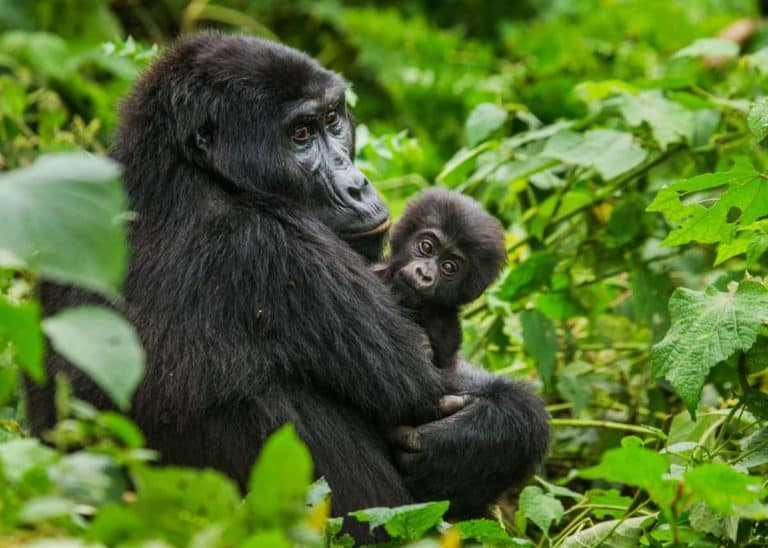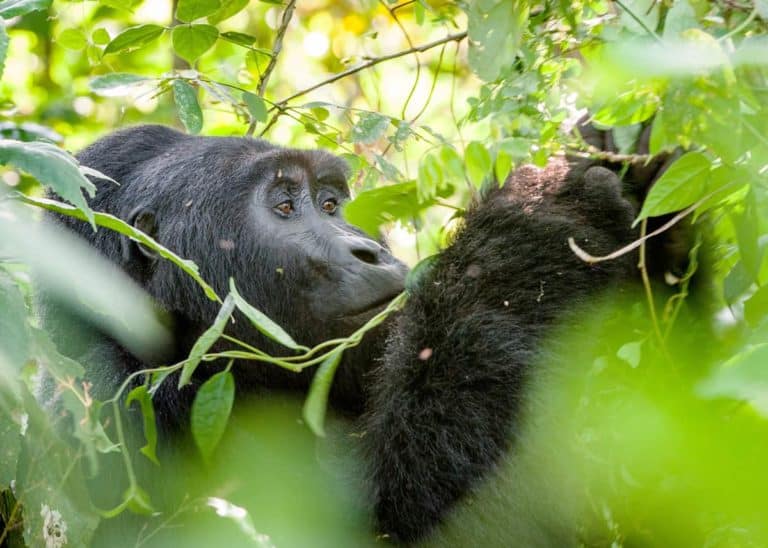9 Types of Tigers: Guide to All Subspecies (Size, Population, Illegal Trade)
How many tiger species are there? Learn about all 9 types of tigers, including population size, weight, range, illegal trade in tiger parts, and unique features. These types are all subspecies of the tiger species.

9 Types of Tigers: (Guide to All Subspecies)
With their grace and powerful form, tigers are some of the most popular animals on the planet. They are definitely one of my favorite animals.
They’ve been immortalized in countless books, movies and mythologies, and just about every culture in the world attaches significance to them.
Before we get to the specific subspecies, here is a quick overview of tigers around the world.
8 Quick Tiger Facts
- Wild Tiger Population: 3,890
- Wild Tiger Population 100 Years Ago: 100,000
- Types of Tigers: 9 Subspecies (3 Extinct)
- Types of Tigers Still Alive: 6 subspecies
- Number of Endangered Subspecies: All tigers
- Biggest Threats: Poaching and habitat loss.
- Where tigers live: 13 countries (Bangladesh, Bhutan, Cambodia, China, India, Indonesia, Laos, Malaysia, Myanmar, Nepal, Russia, Thailand, and Vietnam)
- Number of tigers in Africa: 0
Data source: Animal Planet and others.
Did you know that not all tigers are the same? There are nine sub-species in all, and they can vary in everything from color to size to region.
Let’s take a look at the different types of tigers. By the time that you’re done reading this, you’ll be an expert in these big cats!
1. Siberian Tiger
- Common name: Siberian tiger
- Latin name: Panthera tigris altaica
- Also known as: Korean tiger, Amur tiger, Manchurian tiger, Ussurian tiger
- Range: North Asia (Russia, China, Korea)
- Weight: 389 – 475 lbs (males), 260 – 303 lbs (females)
- Size: 70 – 82 inches (males), 66 – 72 inches (females)
- Endangered Status: Endangered
- Unique Features: Big size, pale fur

The Siberian tiger is generally considered the biggest of the species, though it’s similar in size to the Bengal tiger. Its average size is around 5 – 7 feet long, and some males can reach 10 feet or more. The heaviest on record was a staggering 660 pounds!
The Siberian tiger is also known for its broad chest and large skull. Since it lives in cold, snowy regions, including mountain passes, it has thick fur to help it survive harsh winters. It also tends to be a paler orange than its more vibrant cousins.
A fun fact about Siberian tigers is that they’ve been known to take down bears. While they prefer smaller prey like deer and antelope, they’ll go after bears when food is scarce. Sometimes, the bears strike back by killing young and female tigers.
2. Bengal Tiger
- Common name: Bengal Tiger
- Latin name: Panthera tigris tigris
- Also known as: Royal Bengal tiger, Indian tiger
- Range: Indian subcontinent (India, Nepal, Bhutan, Bangladesh)
- Weight: 397 – 569 lbs (males), 220 – 350 lbs (females)
- Size: 110 – 120 inches (males), 94 – 104 inches (females)
- Endangered Status: Endangered
- Unique Features: Large bodies, white mutation

The Bengal tiger is one of the most well-known tiger breeds. In fact, it’s probably what comes to mind when you picture a tiger. It has orange fur with white tufts around the ears and black stripes down the back, and it boasts strong jaws, powerful hind legs and front paws that can literally decapitate its prey.
Additionally, some Bengal tigers are born with a genetic mutation that gives them white fur and blue eyes. They aren’t actually albino; it’s just a quirk of the genes controlling their pigmentation. Both parents need to carry the gene for a cub to be born this way. It’s a rare coupling, so white tigers represent just one in every 10,000 births.
As one of the oldest tiger species, Bengal tigers have been around for 12,000 – 16,500 years. They date back to the Late Pleistocene period.
3. Indochinese Tiger
- Common name: Indochinese tiger
- Latin name: Panthera tigris corbetti
- Also known as: Corbett’s tiger
- Range: Southeast Asia (Thailand, Vietnam, Laos, Burma, China, formerly Cambodia)
- Weight: 331 to 430 lbs (males), 220 – 290 lbs (females)
- Size: 100 – 112 inches (males), 91 – 100 inches (females)
- Endangered Status: Near critically endangered
- Unique Features: Short, narrow, single stripes

Like its name suggests, the Indochinese tiger is found around the Indochina region of Asia. Its biggest populations are in Thailand, Burma and Vietnam.
It’s sometimes known as Corbett’s tiger, and its scientific name includes corbetti. This is in honor of famous British hunter Jim Corbett. He was often called on to kill man-eating tigers and leopards in the early 20th century.
Like all living tiger species, the Indochinese tiger is endangered, and its numbers are dwindling fast. Some experts say that it should be classified as “critically endangered” now. There are only around 300 – 400 left.
Illegal trade is the main reason for its decline. Just about every part of the tiger can be used in rituals, medicines, clothes, jewelries and wines, so there’s always a demand for them. Pelts can be traded; claws and bones can be ground into pastes and poultices; internal organs can be eaten.
4. Malayan tiger
- Common name: Malayan tiger
- Latin name: Panthera tigris jacksoni and occasionally Panthera tigris malayensis
- Also known as: Southern Indochinese tiger
- Range: Southeast Asia (Malaysia, Thailand, Burma)
- Weight: 220 – 308 lbs (males), 165 – 245 lbs (females)
- Size: 75 – 112 inches (males), 70 – 103 inches (females)
- Endangered Status: Critically endangered
- Unique Features: Small and endangered. No notable physical difference between the Indochinese and Malayan tigers.

The Malayan tiger has many similarities with the Indochinese tiger. In fact, it wasn’t considered a separate breed until the early 2000s. This is why there’s debate about its scientific name: When it came time to give it a unique designation, some people called it malayensis to reflect its geographic location, and others dubbed it jacksoni in honor of big cat conservationist Peter Jackson.
Regardless of what you call them, Malayan tigers are in trouble. They’ve gone from endangered to critically endangered in recent years, and their numbers are still on the decline. There are less than 200 mature adults who are capable of breeding.
Deforestation is one of the biggest reasons for the downfall of the Malayan tiger. Poaching is another. Like the Indochinese tiger, its bones and pelts are used in everything from traditional medicines to cultural rituals, and a tiger kill is considered a great status symbol among hunters. Conservationists are working hard to protect these tigers while there’s still time.
5. South China Tiger
- Common name: South China Tiger
- Latin name: Panthera tigris amoyensis
- Also known as: Amoy tiger, Xiamen tiger, Chinese tiger
- Range: Central and eastern China (Hunan, Fukien, Guangdong and Jiangxi provinces)
- Weight: 287 – 386 lbs (males), 220 – 254 lbs (females)
- Size: 91 – 104 inches (males), 87 – 94 inches (females)
- Endangered Status: Critically endangered and near extinction
- Unique Features: Small, rare, possible blue mutation
The South China tiger is an extremely rare species. In fact, it might even be functionally extinct. There are only 30 – 40 of them left, and they’re all in zoos. The South China tiger hasn’t been spotted in the wild in decades.
So what happened? In the 1970’s, when the Chinese government was clearing large swatches of land for commercial development, they kept running into tiger hordes. They declared them a pest and tried to exterminate them. The number of South China tigers dropped from more than 4,000 to 40.
The good news is that the government has changed its stance and is now trying to protect this critically endangered species. They’re considered a protected class, and zoos in China and South Africa are actively trying to breed them.
Another interesting fact about the South China tiger is that it might have a genetic mutation that gives it blue fur. This has never been proven, but eyewitnesses used to swear that they saw blue-white tigers in the mountains of China. If true, it would be an inherited trait much like the white mutations of the Bengal tiger, and an amazing animal to see!
6. Sumatran Tiger
- Common name: Sumatran tiger
- Latin name: Panthera tigris sumatrae
- Range: Indonesia
- Weight: 220 – 310 lbs (males), 165 – 243 lbs (females)
- Size: 87 – 100 inches (males), 85 – 91 inches (females)
- Endangered Status: Critically endangered
- Unique Features: Smallest breed, genetically isolated, the only surviving tiger species in the Sudra Islands

Outside of zoos, Sumatran tigers are only found on the Indonesian island of Sumatra. Scientists believe that rising sea levels are what separated them from “mainland” tigers between 6,000 – 12,000 years ago, so while all of their cousins have close genetic ties, Sumatran tigers have evolved differently.
They tend to be smaller than other breeds. For example, they have about half of the heft of a Bengal or Siberian tiger. They’re only slightly shorter, but they have lighter builds and weigh significantly less.
Their stripes are another distinguishing feature. They have very dark, defined lines, and they stretch over the entire body. They even have stripes on their forelegs, which not all tiger species do.
Another notable thing about Sumatran tigers is that they’re the only surviving species of tiger in Indonesia. They’re critically endangered, but they’re hanging on. This distinguishes them from both the Bali and Javan tigers that lived in the same area but have gone extinct.
7. Caspian Tiger
- Common name: Caspian tiger
- Latin name: Originally Felis virgata, later Panthera tigris virgata
- Also known as: Hyrcanian tiger, Hyrcan tiger, Turan tiger
- Range: Central Asia and the Middle East (China, Turkey, Iran, Afghanistan)
- Weight: 370 – 530 lbs (males), 187 – 298 lbs (females)
- Size: 106 – 116 inches (males), 94 – 102 inches (females)
- Endangered Status: Extinct
- Unique Features: Large bodies, muted colors
Congregating around the Caspian Sea, these tigers were fierce, powerful creatures with big skulls and even bigger bodies. The largest specimen ever recorded was 11.8 feet long!
Sadly, the Caspian tiger has been declared extinct. There are none in captivity, and they haven’t been spotted in the wild for decades. While it’s possible that there are still undiscovered groups out there, conservationists aren’t holding out hope.
When they were alive, Caspian tigers had muted colors. They were actually called “grey tigers” in their first sightings by 19th century explorers. However, surviving pelts show that they had rusty orange fur with lots of brown.
8. Bali Tiger
- Common name: Bali tiger
- Latin name: Panthera tigris balica
- Range: Indonesia
- Weight: 200 – 220 lbs (males), 143 – 176 lbs (females)
- Size: 87 – 91 inches (males), 75 – 83 inches (females)
- Endangered Status: Extinct
- Unique Features: Formerly smallest tiger species
The Bali tiger used to live on the Indonesian islands along with the Sumatran tiger and Javan tiger, but it hasn’t been seen since the 1930s, and it’s been considered extinct since the 1950s.
When it was alive, it was known for being among the smallest types of tigers.
Its only remnants in the world today are skulls and bones that have been preserved in museums.
9. Javan Tiger
- Common name: Javan Tiger
- Latin name: Panthera tigris sondaica
- Range: Indonesia
- Weight: 220 – 311 lbs (males), 165 – 254 lbs (females)
- Size: Around 90 – 100 inches
- Endangered Status: Extinct
- Unique Features: Extinct but possibly in hiding
The Javan tiger is the last of the “tiger trio” that once dominated Indonesia. Since it went extinct sometime in the 1970’s, not much is known about it.
A cool thing, however, is that there are periodic reports of tigers in the area. In 2009, locals claimed to have seen a tigress with two cubs, and officials found fresh tracks on the ground. In 2010, after the eruption of a volcano, paw prints were seen in the ash. In 2017, a wildlife ranger in a national park took a picture of a tiger-like creature feeding on a bull.
These sightings might not be Javan tigers. They could be leopards or other big cats. And they could be the imaginations of hopeful locals.
10 Tiger Questions Answered
Still have questions about tigers? Nice. Here’s a summary of some of the most common questions. Don’t see an answer to your question? Ask it below, and we’ll do our best to cover it.
1. How many tigers are left in the world?
The wild tiger population is estimated to be 3,890. This is down 96% from 100 years ago (with an estimated 100,000 a century ago).
2. How many types of tigers are there?
There are 9 tiger subspecies. Of these, 3 have gone extinct. That leaves just 6 remaining tiger subspecies.
3. How many species of tigers are endangered?
All tigers are endangered. This includes the 6 remaining subspecies.
4. What are tiger’s biggest threats?
Illegal poaching and habitat loss are the biggest threats faced by tigers around the world.
5. How tiger parts are used: 16 parts explained
Nearly every part of the tiger is used. None of these applications are based in science or medicine. Rather, the use of these products seems based on superstition and religious tradition.
Eyes, organs, blood, flesh, whiskers, brains, and bones have been used to treat almost every type of illness. They have been used as pain killers, aphrodisiacs, and a cure for laziness. They have been used to treat fever, headaches, baldness and toothaches. Some tiger parts are thought to possess spiritual powers – preventing demon possession.
- Skin: to treat mental illness
- Flesh: for nausea and malaria, to improve vitality and tonifying the stomach and spleen.
- Hair: drives away centipedes when burnt
- Brain: to cure laziness and pimples
- Eyeballs: for epilepsy, malaria, nervousness or fevers in children, convulsions and cataracts
- Nose: for epilepsy and children’s convulsions
- Teeth: for rabies, asthma, and sores on the penis
- Tiger bones: Used to make tiger bone wine, an alcoholic drink produced with actual tiger bones. It is thought to cure specific diseases. Some tiger bone wine is actually made with bones from other animals (dog, pig, bear, or horse) and is known as “common” tiger bone wine. When made with the bones of tiger and other big cats, it’s known as “true” tiger bone wine. As you might imagine, the true wine is much more expensive.
- Whiskers: for tooth aches
- Blood: for strengthening the constitution and willpower
- Gallstones: for weak or watering eyes and abscesses of the hand
- Stomach: for calming upset stomachs
- Bile: for convulsions in children
- Tail: for various skin diseases
- Penis: considered an aphrodisiac
- Testes: for tuberculosis of the lymph nodes
The use of these products are primarily by the older generations. Younger generations tend to favor modern medicine over these unproven, traditional products.
Source: Killed for a Cure by Traffic.org (link opens pdf publication)
Amulets and religious use: These are still popular, and include fangs, skin and other tiger parts as religious objects.
Are all tiger parts from wild (poached) tigers? No. Much of the tiger products actually come from tiger farms. These are located in Nepal, China, and Thailand.
6. What are tiger farms for?
Like most farms, tiger farms raise tigers like livestock. It was estimated in February 2018 that more than 8,000 tigers lived on these farms. This is more than double the current wild population. They operate as wildlife sanctuaries and tiger encounters (especially in Thailand).
One famous example is Tiger Temple – a popular tourist attraction that also farmed and sold its tigers on the black market. In a raid back in 2016, 40 tiger cubs were discovered in freezers.
7. Where do tigers live?
Tigers can be found in 13 countries.
- Bangladesh
- Bhutan
- Cambodia
- China
- India
- Indonesia
- Laos
- Malaysia
- Myanmar
- Nepal
- Russia
- Thailand
- Vietnam
8. How many tigers live in Africa?
Zero. There are no wild tigers in Africa.
In Africa, you can find leopards, lions, and cheetahs. But, surprisingly for many, there are no tigers living in the wild in Africa.
9. Are there more tigers in captivity in Texas than in the wild?
Maybe. Estimates range from 2,000 to 5,000 tigers living in captivity in Texas. That means that there could be more tigers in Texas than in the wild globally. There are less than 4,000 tigers living in the wild.
At the least, this huge captive population of tigers in Texas, makes Texas home to the second largest population of tigers (after India) according to dw.com.
10. Are there more tigers in captivity in the United States than in the wild?
Yes. There is an estimated 7,000 captive tigers in the United States. And less than 4,000 living in the wild around the world.
In addition, there is an estimated 1,600 captive tigers in Europe. These include zoos, circuses, and private ownership.

More reading: Jaguar vs Tiger: 7 Key Differences Compared
Your Turn
Which of these is your favorite? Have a tip or fact to share? Join me below!







Hey, just wondering who these photos belong too? they are incredible and I chose them from a project, but Im not sure who to accredit
We use these under license and you can attribute our site as the source. I don’t have easy access to the original photographer’s details, as we purchased these rights through an agency.
THAT WAS AMAZING I ALSO LIKE TO STUDY ABOUT ANIMALS AND IT ALSO INTRESTED ME BECAUSE THIS IS THE NEWEST FACT I EVER SEEN
Thanks Joel, we love new facts too!
my kids are going to love this
so cool i am a techer by the way
Why is the Sumatran Tiger’s size bigger than the Siberian Tiger’s size?
because they have different diet and they live in different habitat
@JOEL THOMAS PAUL,
Ok how is siberian tiger so freaking small and THE SHORTEST TIGER OF ALL OTHER TIGERS?!?!???. With only 70-82 inches tall. Even the smallest tiger sumatra tiger is 87-100inches tall. Tallest of siberian tiger is a midged compared to most shortest of Sumatra tiger, you serious with this claim. I seriously doubt your information.
Siberian tiger might as well be a weasel then 😒